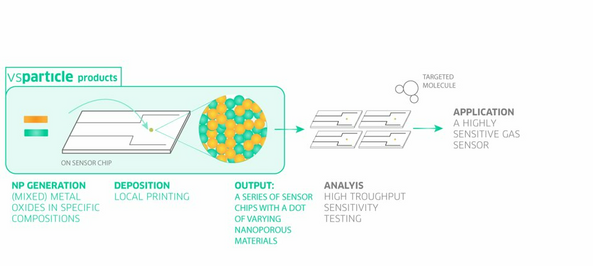Unlocking the full potential of new nanomaterials
The unique, highly porous materials made with VSParticle technology create a wide variety of application possiblities: from industrial applications in renewable energy or environmental monitoring to self-driving (automated) labs in materials research.
And this is just the start...

Catalyst Coated Membranes (CCM)
Nanoporous noble metal layers and alloys for green hydrogen production.VSParticle can simplify the production process of CCMs, and catalyst loading can be reduced without compromising performance or durability.
Gas Sensors
Wide variety of sensing layer materials for air quality monitoring.With VSParticle technology high-quality nanoporous sensing layers can be produced, with an outstanding surface to volume ratio, high purity and tunable layer-thickness.


Electrocatalysis
Solid catalysts are at the heart of 90 % today’s energy and chemical industries. Catalysts have a vital role in both established and emerging industrial processes, and remain indispensable as we develop new processes while addressing societies greatest challenges linked to sustainable energy production and climate change.
Heterogeneous catalysis
Heterogeneous catalysts in particular are widely adopted in today’s chemical industries, contributing in over 90 % of all industrial processes to make them more efficient, cleaner and sustainable. Developing the mainstream heterogeneous catalysts of tomorrow requires a fundamental understanding of today’s state-of-the-art catalysts.


SERS Chips
The key element to achieve the enhancement of the scattered laser signal is the substrate on which the probe is placed. Size, shape and distribution of particles of the nanostructure surface can significantly affect the SERS substrate’s enhancement effect. Therefore, the extraordinary surface sensitivity of SERS substrates is closely related to the advancements in nanomaterials engineering and nanostructure fabrication.
Nanoaerosol Studies
Nanotechnology is continuously growing and engineered nanoparticles are used as building blocks for many advanced materials, catalysts or consumer products. However, the increasing amount of airborne nanoparticles has raised significant concerns regarding their effect on environment and human health. Therefore, the need to develop monitoring techniques and methods to determine exposure limit or toxic health effects of nanoparticles has also increased.


Quantum Materials
Many day to day phenomena in all kinds of materials find their origin in quantum mechanics. Conductivity could for example be described by the transport of electrons, colour by the behaviour of photons and magnetism by the interaction of spin states. Some materials can however be designed such that also on a larger scale, or at higher energies, quantum effects remain significant, giving rise to unique properties that cannot be explained in a classical way.